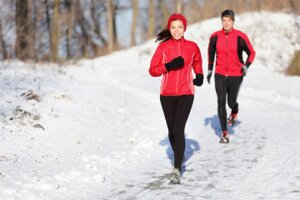
If you prefer to exercise outdoors, the shortening days may impact your ability to squeeze in those early morning or evening workouts. And, if you’re not a fan of the colder weather or have a condition like arthritis or asthma that may be affected by the falling temperatures, then you may have questions about outdoor exercise as the days get colder and darker.
Here are some guidelines about the best time to exercise and safety precautions to take when you’re working out or are simply being active in cold weather.
Best Time to Exercise
The answer to the first question is simple. The best time to exercise is whatever time you can most consistently do so. There are some important considerations, including the safety of the area where you’ll be exercising, the heaviness of local traffic and the presence or lack of adequate lighting. However, identifying the ideal time to work out is meaningless if it’s not a good time for you.
So, figure out what time of day will allow you to stick to your program, whether it’s early morning, on your lunch break, immediately after work or later in the evening. There is no perfect time for exercise, so find what works for you and do your best to exercise on as many days as possible while keeping a close eye on safety.
How to Exercise in the Winter and Fall
Even if you are a true outdoor exercise devotee, it’s a good idea to have some indoor exercise options for when the weather turns particularly bad. Consider trying some group fitness or online classes like yoga and circuit training to provide some variety and keep you active when exercising outdoors is simply not possible.
Fall is also a great time to try some new activities that take advantage of the beauty of the changing season. If you’re an avid walker or jogger, try hiking, trail running or mountain biking. In addition to the gorgeous scenery, hiking provides a great cardio and lower-body workout. Depending on the terrain where you live, hiking can also provide a form of interval training as you alternate between climbing hills and moving along more gentle ridgelines. And, like all forms of outdoor exercise, hiking is a great stress reliever that can boost your mood and overall health.
If hiking or trailing running causes pain, you’ll be happy to hear that biking is easier on the joints. For first-time cyclists, start on flatter surfaces before progressing to mountain biking on hills or at higher elevations. Either way, you’re getting a great cardio workout without the wear and tear on your joints that come with running or hiking.
Cold Weather Exercise Tips
If you prefer to stick with the walking, jogging or running program you’ve been doing all summer, cooler weather and decreased humidity can actually make your workouts much more comfortable and thereby reduce your feelings of fatigue and improve performance. So, this might be the ideal time to push yourself and build your endurance.
No matter what activity you choose, there are a handful of safety precautions you should consider as the seasons change:
- Check the weather. This is the most important safety tip, especially if you live in an area where temperatures sometimes drop quickly or storms tend to move in without warning. The last thing you want is to be 3 miles from your car on a remote trail when storm clouds roll in. Before you head outdoors, check the local weather and don’t be afraid to cancel an outing if you’re unsure about the safety of the day’s weather.
- Connect with family or friends. Make sure others know where you’ll be in case of emergency – especially if your workouts take you off the beaten path. Tell a friend or family member where you’ll be parked, what direction you’ll be headed and how long you plan to be out.
- Dress appropriately. Wearing multiple layers of winter exercise clothes can help you stay safe and warm when exercising outdoors. The best combination may be a moisture-wicking bottom layer, a warmer fleece or wool mid-layer and a lighter water-resistant outer layer. Your body temperature will fluctuate more in cooler weather, so remove layers as you get too warm and put them back on as you cool off. Wear shoes with good traction, especially if you’ll be hiking or running on trails that are slippery with fallen leaves or snow. Finally, wear bright-colored or reflective clothing so drivers of passing cars can see you.
- Stay hydrated. Staying hydrated is just as important in cooler weather as it is in the heat. Drink water before, during and after your workout and be sure to carry water or a sports drink if you’ll be spending a long day outdoors.
- Prepare as you would for any workout. Even if you’re enjoying a nice hike with friends and frequently stopping to soak in the views, you’ll still want to treat the outing like any other bout of exercise. In addition to being properly hydrated, eat the right foods to provide fuel for your workout, bring some healthy snacks with you if you’ll be outdoors for a long time, warm up beforehand and cool down afterward.
Finally, don’t lose sight of the fact that physical activity doesn’t have to be structured, planned or particularly intense to yield important health benefits. Outdoor sports, or even just throwing or kicking a ball around with your kids will do the trick, as will yard work and outdoor chores you’ve been ignoring because it’s been too hot outside. Any activity that takes you outdoors and gets your heart pumping will produce important health and wellness benefits.
From:Cedric X. Bryant
Post time: Nov-30-2022